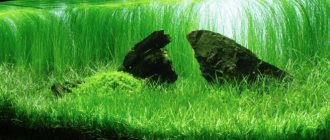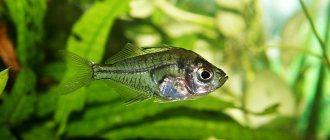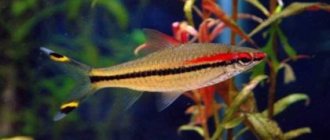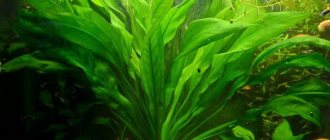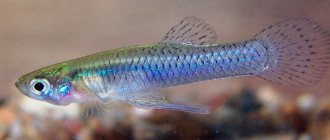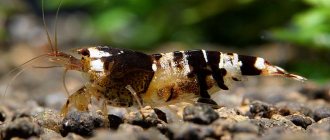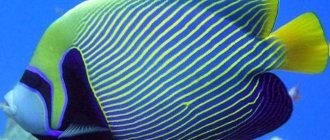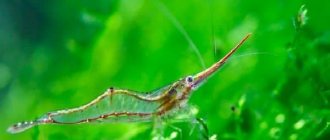CONTENTS OF ECHINODORUS GOREMANIAN
Recommendations for keeping the plant vary as usual.
I basically support the approach of M. Zierling, who proposes the following: “Echinodorus Goreman can be kept in moderately warm and tropical aquariums. The most favorable water temperature is 22-26°C. Echinodorus tolerates increases in water temperature to 28 and even 30°C very well, but under such conditions it needs to have a rest period of 1-1.5 months twice a year, reducing the temperature to 20°C. This is best done in spring and autumn. Arrow of Echinodorus Goreman
Echinodorus Goreman tolerates a long-term decrease in temperature to 14-16 ° C without harm to itself, but its growth almost stops. Water hardness is desirable not lower than 6-8°; Although the plant can be kept in very soft water for a long time, its condition noticeably worsens. With regard to the active reaction of water, Echinodorus Goreman has very strict requirements (pH in the range of 7-8.5). A decrease in pH to 6.8 or less leads to rapid degradation of the plant. It is very advisable to regularly change up to 1/5 of the water volume approximately once every 2 weeks” (Zierling M. Aquarium and Aquatic Plants). The only difference is that for me they overwinter at 12-15°C.
The only point with which everyone agrees: the soil must be nutritious. Each person provides this condition in their own way. In particular, I use a mixture of clay, black soil and cow manure in a volume ratio of 3:2:1 as root feeding.
In conclusion, I would like to appeal to lovers who do not yet have this wonderful plant: feel free to purchase it. The difficulties promised to you are clearly exaggerated.
N. TARASENKO
Aquarium Magazine 2010 No. 2
SHARE THE ARTICLE ON SOCIAL NETWORKS
Preparing the soil and planting site
The best substrate for echinodorus is considered to be gravel of a fraction from 3 to 7 mm or coarse sand. The soil must be nutritious and well ventilated. For some varieties, special instructions should be taken into account in the form of mandatory substrate thickness and siltation.
Echinodorus are quite tolerant of the plant environment; it is enough to select crops that are compatible in water composition, light and temperature requirements. The worst neighbor for Echinodorus is considered to be Cryptocoryne, and the most successful combination is called Saggitaria.
When planning planting, you should take into account the final size of the plant indicated in the description of the variety. This will help avoid mistakes with crowding out the crop and problems with shading.
Keeping Uruguayan Echinodorus in an aquarium
The bush is most often used for wide and large aquariums. It prefers to grow in water that has the following indicators:
- temperature +20°…+28°C;
- dH – 2-15;
- pH – 6-7.5.
The plant tolerates slightly alkaline water well, but then it will develop much more slowly. In this case, Echinodorus will lose its attractive appearance. The bush loves bright light, so fluorescent lamps from 60 Lm/l are well suited for it. Daylight hours should last 6-12 hours. Water changes, aeration and filtration are required.
Planting rules and soil
Planting Echinodorus in the ground.
For Echinodorus, the nature of the soil is important. It should be nutritious with a high silt content. This allows for good growth. Without feeding, the leaf blades of the bush begin to turn pale, so it is recommended to place charcoal and clay in the soil. The benefits will come from divalent iron salts, the lack of which leads to the disappearance of the red color of the leaves. If the soil is too old, the Echinodorus roots will rot. A 20% water change helps avoid this. This procedure is carried out every week.
This plant is characterized by strong rooting, so it can be used to keep burrowing cichlids and fish species that lay eggs on leaf blades. To plant Echinodorus, prepare a hole, place a bush in it, straighten the rhizome and fill it up.
If it is not possible to purchase soil for the plant, it can be planted in a pot with the addition of garden soil. A small amount of soil is placed in the container, the plant is planted there and covered with soil up to 2/3 of the pot. A thick layer of small river pebbles is poured on top. After this, the pot is placed in the aquarium.
What kind of soil is needed?
Like many other aquarium plants, Echinodorus uruguayan loves fairly nutritious substrates. Ideal for this representative of the flora would be special purchased soil, saturated with minerals. Such substrates for Echinodorus are laid with a layer of 5-15 cm and covered with pebbles on top.
If you can’t purchase special aquarium soil, you can simply plant this plant in a pot with garden soil. In this case, the soil is also covered with pebbles on top. The pot for Echinodorus needs to be large enough. In the future, it will have to be masked not with sand and pebbles, but with some aquarium decor items.
How to propagate
The plant reproduces by dividing the rhizome. The bush creeping along the surface of the ground has dormant buds on the back of the rhizome, from which young plants emerge. The root is cut into pieces, each with a developed bush. Young echinodorus are separated from the rhizome when 3-4 roots and 5-6 large leaves are formed. They are placed on their side and the root system is pressed with a stone.
Another method of propagation is by daughter plants appearing on flower shoots floating on the surface of the water. After 4-5 leaves appear, the young bushes are cut and planted in a pot with soil without fertilizing. The plants grow small, making them suitable for small aquariums.
Editorial: Agamiks
To bookmarks
How to plant
Rules for planting in the ground:
- First, inspect the plant, carefully remove damaged leaves and roots. Then it needs to be disinfected for 20 minutes in a weak solution of potassium permanganate or rinsed in a solution of hydrogen peroxide (1 tsp/1 l).
- Dig a small hole in the soil, place a ball of clay for better growth, carefully place the root and cover with soil.
Rules for planting in pots:
- You will need a small pot 7-8 cm high, in which you need to drill holes.
- Place a mixture of garden soil and fine gravel on the bottom, place a ball of clay, then a plant and carefully cover with fine gravel or sand.
Echilodorus grows quickly and has a powerful root system, and when planted in pots, it will need to be transplanted into larger containers every 6-12 months.
Echinodorus parviflora
Landing algorithm
Echinodorus, all types, photos and descriptions of which were presented earlier, are easy to plant both in adulthood and at the seedling stage. For all plants, it is considered sufficient to distribute the existing roots throughout the soil.
Before planting, only shoots that are too long are trimmed. If the roots are healthy and white, they do not need to be shortened.
Rules for planting echinodorus:
- The substrate is best made from a mixture of sand and fine rounded stones. The thickness of the soil may vary in each case. On average, 2–4 cm of substrate is enough for echinodorus.
- The soil is pre-fertilized, and pieces of clay or boiled peat are placed under the rhizomes in the form of fibrous rosettes.
- The roots of the seedlings are straightened and dug in.
- An important rule is the complete penetration of the roots, and the youngest leaf of the bush (growth point) should remain above the substrate.
- For beginner aquarists, it is appropriate to grow echinodorus directly in pots. This technique is especially convenient if you want to keep plants to a small size.
- You can place a few lumps of garden soil at the bottom of a small flower pot, and fill the rest of the volume with regular aquarium soil.
- The walls and bottom of such a container should have many holes so that the roots do not rot.
When purchasing seedlings grown using the “dry” method, the plant should not be immediately immersed in an aquatic environment. First, Echinodorus should spend several weeks with its roots in water and its leaves in the air. Then the plant is gradually immersed in water over 15–20 days.
Reproduction
At the age of about a year, Echinodorus blooms and forms seeds, but they, as a rule, do not germinate. Many daughter plants are formed on the flower shoots. They can be separated from the arrow after the formation of 4-5 leaves and root lobes. It is best to press the peduncle to the ground of the aquarium, then the daughter plants will easily take root and develop quickly. In this way, it is advisable to propagate Echinodorus indoors.
It is better to keep Echinodorus sellovianus, like most amphibian plants, in a humid greenhouse rather than in an aquarium. In a humid atmosphere, nutritious soil and at high temperatures, it grows very quickly and reproduces easily and productively.
How do they reproduce?
Anyone who appreciates naturalness and naturalness even in water will be happy to plant beautiful green spaces in their aquarium. Echinodorus tenderus (Echinodorus tenelius) is quite a suitable option for this. If the conditions are right, it will reproduce on its own and quite quickly. By letting out its antennae on neighboring areas of the ground, it seems to send a signal for the relocation of its soul. A new rosette is born at the end of the antennae. Gradually it attaches to the ground, takes root and begins to grow. Thus, the soil is increasingly overgrown with plants such as Echinodorus latifolius, Echinodorus uruguayan, Echinodorus osiris, Echinodorus bartha.
If you set a goal to create zoning of the aquarium territory, you can use species such as Echinodorus Asherson, Echinodorus parviflora, Echinodorus cordifolia, Echinodorus uruguayan. You can regulate the intensity of their growth manually by removing nascent rosettes or interrupting the mechanism of antennal formation. Then the selected area of the territory will become an island of positivity and, perhaps, a favorite place for spawning of individual fish.
If such a cheerful family takes root, it will be a real decoration of the aquarium. You can also play with size. Thus, Echinodorus vesuvius will look original against the background of Echinodorus Barthes, and Echinodorus osiris will favorably emphasize its originality in comparison with Echinodorus Ascherson.
All inhabitants of the aquarium world, such as the Echinodorus plant, including the small-flowered version, will be grateful for creating optimal living conditions for them. In response to your care, they are ready to thank you with their beauty, warmth and comfort in your home.
Post Views: 3,354
general description
Even in small aquariums, Echinodorus of this variety can grow very large. Therefore, it is usually placed in the background behind other plants. At the same time, Echinodorus are planted in aquariums, even large ones, in most cases one by one. Due to their large size and brightly colored leaves, such plants look very impressive under water. Photos of Echinodorus uruguayan are presented on the page. As you can see, this plant is actually simply luxurious.
This representative of the underwater flora receives nutrients from the soil. One of the features of this plant is the absence of a stem. The leaves of Echinodorus grow directly from its roots. The color of this beautiful plant is green in most cases. But sometimes you can also see red Echinodorus Uruguayan in aquariums. The content of both of these forms is technologically no different. In any case, both the green and red leaves of this plant are large in size. They can reach 50 cm in length and 8 cm in width.
Editorial: Tropheus startatum
The density of the leaves of the Uruguayan Echinodorus when grown under water is not too high. If there is good lighting in the aquarium, their plates are translucent and look very bright. The leaves of this plant never rise above the water. Their upper part floats on the surface of the water in the aquarium.
A fairly large number of leaves can grow in one rosette of Echinodorus. Therefore, this representative of the underwater flora actually looks very impressive. Typically, the rosette of one such plant includes 8-10 full leaves.
Origin
In the wild, this beautiful plant is found mainly in South America in fast-flowing rivers. A feature of Echinodorus uruguayan, among other things, is that under different environmental conditions it can have different sizes and colors. This underwater plant is found quite often in South America. But there is especially a lot of it in the rivers in the south of this continent.
Tenelli Fasset
The first section of the genus Echinodorus is characterized by the following characteristics: flowers have no more than 20 pistils (usually fewer), the ribs on the seeds are smooth and never jagged, the shape of the leaf blades is linear-spear-shaped to narrow-elliptical, there are 6-9 stamens. This section contains dwarf species of the genus Echinodorus, which are distributed from the temperate zone of the United States to the temperate zone of Argentina. In the tropics these species are most often perennial; in the middle zone they are usually annual. The flowers are relatively small and reach a diameter of 0.6-1.5 cm. Species belonging to section Tenelli are the only members of the genus that, like plants from the genera Sagittaria and Vallisneria, reproduce by stolons and often form above- or underwater green thickets consisting of many hundreds of plants. The formation of young plants on peduncles occurs relatively rarely. All species form surface and underwater forms that differ from each other. They grow in damp places, in periodically flooded places, or constantly under water. In permanent underwater culture, these species do not bloom, remaining sterile, and reproduce exclusively by vegetative means. Studying these species using herbarium materials is very difficult. On dry plants it is only possible, and even then with difficulty, to recognize the most important characteristics, for example, the size of the corolla.
The section contains 6 types:
1. Echinodorus tenellus 2. Echinodorus isthmicus (Fasset) 3. Echinodorus austroamericanus (Rataj) 4. Echinodorus latifolius (Seubert) (Rataj) 5. Echinodorus angustif olius (Rataj) 6. Echinodorus quadricostatus (Fasset)
SECTION II
Peculiarities
The versatility and hardiness of Echinodorus allows them to be used to decorate a wide variety of ecosystems.
Aquarists note the following advantages of culture:
- the ability to choose a variety for an aquarium of any size;
- an abundance of simple and decorative forms with spectacular colors;
- compatibility with most aquarium plants;
- ease of care.
Among the disadvantages of growing Echinodorus, their attractiveness to large fish species is noted. Tender leaves are often eaten or sucked out not only by adult catfish and cichlids, but also by some fry. Nevertheless, some species of Echinodorus are recommended specifically for cichlids. These are varieties with large, harsh leaves.
Echinodorus is a large genus consisting of plants for every taste. All species (and there are more than 30 of them) can decorate an aquarium, terrarium or greenhouse. Photos and descriptions of plants show not only excellent decorative properties. Echinodorus provide oxygen, support the ecosystem, and serve as shelter for aquarium fish, reptiles and amphibians.
Description
Echinodorus are mainly represented by herbaceous aquatic perennials. Some of them, for example, Echinodorus berteroi, are cultivated as annual plants.
IN THE PHOTO: Echinodorus bertera, widespread in Central, South America and the West Indies.
The height of representatives of the genus is 10–70 cm. Some wild specimens reach 1 m in height.
The root system is powerful, develops and grows quickly. Echinodorus uruguayensis, Echinodorus subalatus, Echinodorus major and many other varieties form a rhizome.
IN THE PHOTO: Root system of Echinodorus.
Most varieties have short or absent stems. The leaves are sessile, collected in basal rosettes or located on long petioles. Leaf blades are lanceolate, ribbon-shaped, elliptical, heart-shaped or linear. The edges are solid or wavy. Color green, reddish-brown, mottled.
IN THE PHOTO: Leaves of Echinodorus variety 'Reni'.
Inflorescences are paniculate, less often umbellate, whorled from 1–18 whorls. Flowers 1–6 mm. in diameter. The color of the petals is predominantly white. Pistils are yellow or green.
IN THE PHOTO: Flower of Echinodorus macrophyllus.
The seed fruits have the shape of triangular nuts. Brown seeds are spherical or elongated, ribbed, 1–2 mm long.
IN THE PHOTO: Fruit and seeds of the species Echinodorus cordifolius.
Popular varieties and varieties
Decorative hybrid varieties are popular in aquarium and terrarium culture. The cultivar of Echinodorus Uruguayan 'Rubin' reaches 60 cm in height, ideal as a tapeworm. It is undemanding to the soil and practically does not suffer from water hardness. The unusual red-brown color allows you to include 'Rubin' in floral compositions of Echinodorus and other aquarium plants.
From the editor: Cichlazoma eight-striped or bee
IN THE PHOTO: Cultivar of Echinodorus uruguayan 'Rubin'.
The hybrid variety series Dschungelstar from the German nursery Dennerle is distinguished by its variegated leaves: from soft green with light red spots to almost black.
IN THE PHOTO: Compact hybrid of the Dschungelstar series No. 2 'Kleiner Bär'.
This group includes slow-growing compact varieties, such as 'Kleiner Bär' and 'Tornado', and medium-growing varieties intended for large aquariums. The latter include 'Piton', 'Ozelot Gold', 'Grosser Osiris'.
IN THE PHOTO: Popular hybrid Dschungelstar No. 3 'Piton'.
Echinodorus horizontalis, Echinodorus grandiflorus, and Echinodorus cordifolius are successfully grown at home.
The variegated variety of Echinodorus cordifolia 'Tropica Marble Queen', bred in the Singapore nursery Oriental, is widespread. With high decorativeness of above-water and underwater leaves, this cultivar is unpretentious in terms of maintenance and care.
IN THE PHOTO: Variety 'Tropica Marble Queen'.
Possible diseases and pests, ways to get rid of them
Leaf damage or root diseases in Echinodorus are always associated with unsuitable lighting conditions, temperature or imbalance in the chemical composition of water.
Signs of plant degradation, taken for a “disease”:
- leaf necrosis (brown spots);
- darkening of the growing point (death of young leaves);
- changing the shape of the plates (for example, needle-like folding);
- “decay” of the bush (increasing looseness of the rosette and falling off of adult, healthy leaves);
- vitreousness of the leaves (transparency of the plates followed by disintegration).
Yellowing of Echinodorus leaves occurs due to improper care of the plant.
Measures to restore the health of Echinodorus:
- The first most important procedures for such symptoms are considered by aquarists to be the regulation of light and temperature.
- When acceptable indicators are achieved, soil aeration/siltation and the condition of the Echinodorus root system are checked.
- Lack or excess of nutrients in water can be checked with special tests. Both deficiency and too high content of macro- and microelements lead to plant degradation.
- Fluctuations in the hardness of tap water used during water changes also affect the appearance of Echinodorus.
- It is especially recommended to monitor the content of potassium, magnesium, calcium, and phosphorus. Experienced aquarists do not advise overusing liquid fertilizers and soil tablets.
If the growing rules are followed, tropical swamp plants are quite sufficient in the natural matured environment in the aquarium. Additional nutrition is administered only if there is a clear shortage of some element, as determined by test results.
It is easier to plant Echinodorus if you trim off the longer roots near the rhizome, leaving only enough length to provide sufficient adhesion to the substrate.
The reason for the suspension of growth and change of leaves in Echinodorus can also be stress from replanting, a radical change of water, or a sharp change in temperature. In such cases, the plant is given rest and it recovers on its own.

